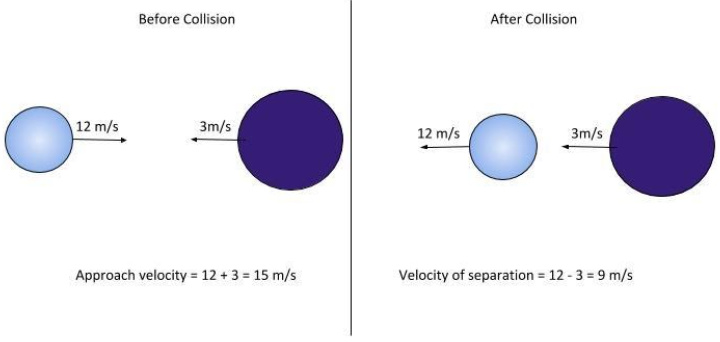
What will be the coefficient of restitution if a ball (v = 12 m/s) collides with another very heavy ball moving in the opposite direction with a speed of 3 m/s & the ball rebounds with a velocity of 12 m/s.
Answer
560.4k+ views
Hint: This is a question based on the concept of law of conservation of momentum. The law of conservation of momentum states that if no external force is acting then the linear momentum of an isolated system is always conserved. I.e the product of mass and velocity will remain the same before the collision as well as after the collision.
Complete step by step solution:
Consider a ball of certain mass moving with a velocity of 12 m/s strikes a comparatively heavier ball which is moving with a velocity of 3 m/s. After the collision, this lighter ball rebounds with a velocity of 12 m/s, as shown in the figure.

Now, the question is what will happen to the heavier ball, since there is no external force acting the momentum of the system will be conserved. Let. m & M be the masses of lighter and heavier balls respectively. Now the initial momentum (Pi) is given by,
${P_i} = 12m + 3M$
Assume v is the velocity with which the heavy ball is moving final momentum (Pf) or the momentum after the collision is given by,
${P_f} = 12m + vM$
Now according to the law of conservation of momentum, we can say that,
${P_i} = {P_f}$
Hence the final velocity of the heavy ball will be, v = 3 m/s and the ball will keep moving in the same direction.
We know that the coefficient of restitution is given by,
$e = \dfrac{{{\mathbf{Velocity}}{\text{ }}{\mathbf{of}}{\text{ }}{\mathbf{separation}}{\text{ }}}}{{{\mathbf{Velocity}}{\text{ }}{\mathbf{of}}{\text{ }}{\mathbf{approach}}}}$
From the figure put the values of the velocity of approach and velocity of separation in the above equation,
$e = \dfrac{9}{{15}}$
$e = 0.6$
Hence the coefficient of restitution for the given case will be 0.6.
Note: The coefficient of restitution is a parameter related to the collision of two bodies. The ratio of the velocity of approach to the velocity of separation is known as the coefficient of restitution. The value of the coefficient of restitution lies between 0 to 1 (0 < e < 1). For perfectly elastic collision e = 1.
Complete step by step solution:
Consider a ball of certain mass moving with a velocity of 12 m/s strikes a comparatively heavier ball which is moving with a velocity of 3 m/s. After the collision, this lighter ball rebounds with a velocity of 12 m/s, as shown in the figure.

Now, the question is what will happen to the heavier ball, since there is no external force acting the momentum of the system will be conserved. Let. m & M be the masses of lighter and heavier balls respectively. Now the initial momentum (Pi) is given by,
${P_i} = 12m + 3M$
Assume v is the velocity with which the heavy ball is moving final momentum (Pf) or the momentum after the collision is given by,
${P_f} = 12m + vM$
Now according to the law of conservation of momentum, we can say that,
${P_i} = {P_f}$
Hence the final velocity of the heavy ball will be, v = 3 m/s and the ball will keep moving in the same direction.
We know that the coefficient of restitution is given by,
$e = \dfrac{{{\mathbf{Velocity}}{\text{ }}{\mathbf{of}}{\text{ }}{\mathbf{separation}}{\text{ }}}}{{{\mathbf{Velocity}}{\text{ }}{\mathbf{of}}{\text{ }}{\mathbf{approach}}}}$
From the figure put the values of the velocity of approach and velocity of separation in the above equation,
$e = \dfrac{9}{{15}}$
$e = 0.6$
Hence the coefficient of restitution for the given case will be 0.6.
Note: The coefficient of restitution is a parameter related to the collision of two bodies. The ratio of the velocity of approach to the velocity of separation is known as the coefficient of restitution. The value of the coefficient of restitution lies between 0 to 1 (0 < e < 1). For perfectly elastic collision e = 1.
Recently Updated Pages
Why are manures considered better than fertilizers class 11 biology CBSE

Find the coordinates of the midpoint of the line segment class 11 maths CBSE

Distinguish between static friction limiting friction class 11 physics CBSE

The Chairman of the constituent Assembly was A Jawaharlal class 11 social science CBSE

The first National Commission on Labour NCL submitted class 11 social science CBSE

Number of all subshell of n + l 7 is A 4 B 5 C 6 D class 11 chemistry CBSE

Trending doubts
What is meant by exothermic and endothermic reactions class 11 chemistry CBSE

10 examples of friction in our daily life

One Metric ton is equal to kg A 10000 B 1000 C 100 class 11 physics CBSE

1 Quintal is equal to a 110 kg b 10 kg c 100kg d 1000 class 11 physics CBSE

Difference Between Prokaryotic Cells and Eukaryotic Cells

What are Quantum numbers Explain the quantum number class 11 chemistry CBSE




